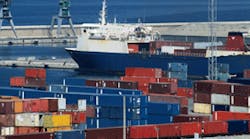The Ports of Long Beach and Los Angeles will take a two-tiered approach to cutting truck traffic and pickup times by operating its terminals until 3 a.m. and on Saturdays starting in mid-July, while levying “traffic mitigation fees” for each container moved during peak hours.
PierPass, the nonprofit organization levying the fees, will charge $40 per TEU (20-ft. per equivalent unit), or $80 for a 40-ft. container during peak hours. The moneys collected will be used to cover the additional administrative and operational expenses to terminal operators for extending work hours. Beneficial cargo owners, and not trucking companies and water carriers, will be responsible for the fee.
The fees will fund an added $156 million annual cost for the terminals to operate the program, the Long Beach Press Telegram reported. Bruce Wargo, general manager of PierPass, said the goal is to move 15% to 20% of containers in off-peak hours in the first year, 30- to 35% in the second, and 40- to 45% in the third, the Long Beach Press Telegram reported.
The port-wide off-peak system contrasts with Maher Terminals, the largest container terminal operator in the Port of New York and New Jersey, which has been operating extended hours from 6 a.m. through midnight for just over a year but doesn’t levy a fee, said Sam Crane, vp—external affairs.
“We did it because, obviously with volumes growing, we want to encourage people to pick up at the least crowded time,” Crane told Fleet Owner. “However, so far, it’s not as successful as we’d like. It’s not a problem when there’s someplace open to receive the container, but we’re the only terminal at the port to do this and that’s been a challenge.
“It has cost us money to do this and it hasn’t been on the positive side of the bottom line,” Crane added. “But we see this as an investment into a long-term trend.”



